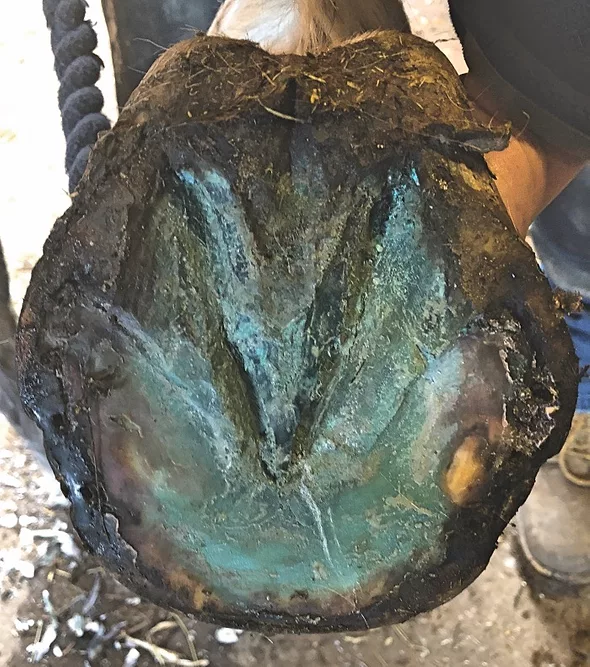Much of the country is celebrating the arrival of spring, but let’s face it — it’s mud season. As the paddocks and pastures languish into a soupy mess, you can almost hear the revelry of the bacterial jamboree that is the horse’s hoof.
Like any good bouncer, the farrier must make their presence known and break up the party. While there are a variety of antimicrobial products on the market, copper sulfate remains the most popular. Applying it can get tricky, though.
Farriers have various ways of applying copper sulfate to the bottom of a horse’s foot. Travis Koons, CJF, of Show Low, Ariz., rolls impression material in a container of copper sulfate. Royal Palm Beach, Fla., farrier Curtis Burns, APF-I, stirs it into his adhesives when gluing shoes or patching hoof cracks. Cornwall, England, farrier Simon Moore, FWCF, shared his technique during the 20th annual International Hoof-Care Summit in Cincinnati, Ohio.
“I use an adhesive spray, like carpet adhesive, on the solar surface,” he explains, “pour the copper sulfate on the areas I want to address and then put dental impression material over it.”
Health Risks
Regardless of its popularity, it’s important to note that copper sulfate has risks.
According to the Environmental Protection Agency, the maximum allowable limit of copper sulfate is 1 part per million or less in drinking water. Generally, toxicity occurs at higher concentrations; however, the limitation is necessary to maintain “acceptable taste” and safety of drinking water. When exposure to copper sulfate occurs in larger quantities, your health is impaired.
Copper sulfate is rapidly absorbed into the body when eaten, inhaled or in contact with organs such as the eye. While excess copper sulfate typically evacuates the body, it binds to proteins and can remain in various organs.
Farriers admittedly won’t add copper sulfate to water and drink it like Tang, but application to the horse’s foot can be tricky. Wigan, England, farrier Samuel Rice was applying copper sulfate powder to a frog when a gust of wind blew some of it into his face. Despite wearing safety glasses, it quickly affected his vision.
“As soon as I felt the powder hit my eyeball my first reflex was to blink repeatedly, which only helped to dissolve the powder and smear it across my eyeball,” Rice told American Farriers Journal in 2019. My vision in that eye immediately turned a vivid shade of blue and I felt an intense burning pain.”
Although his eyes were quickly flushed with water, copper sulfate lived up to its reputation that it rapidly absorbs into the body.
“Within minutes, it was so swollen I could no longer open it, and when I forced it open, I was completely blind,” Rice says. “Obviouslym at that point panic set in, and I rinsed it even more. My sight started to return within about 5 to 10 minutes, but it took probably a good 20 minutes before I could see clearly again. The eye was still swollen shut at that point, but I at least knew that I hadn’t been permanently blinded.”








